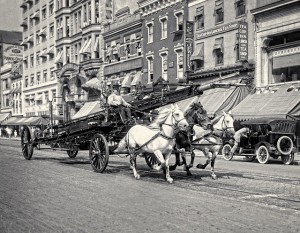Homeowner’s Insurance is a broad type of insurance coverage designed to cover a home and the property it sits on. This insurance is very broad, wrapping many different types of coverage into one package.
If you want to take out a mortgage on a home, the institution you borrow from will probably require you to have some level of Homeowner’s Insurance, if only to make sure if there is a disaster they do not lose their collateral on the loan. Homeowner’s insurance is like a broader form of Renter’s Insurance – it is a combination of property insurance and liability insurance.
History of Homeowner’s Insurance
 What we now call “Homeowner’s Insurance” started in the 1600s as insurance against homes burning down in a fire (it was created in direct response to the Great Fire of London). In the era before public fire fighters, private insurance companies would sell Fire Insurance to homeowners. That insurance company would then have its own staff of fire fighters who would put out fires at any insured home. There were many examples of the fire fighters arriving to a scene of a fire at an uninsured home (or a home insured by another company) and letting the home burn until the owners paid the company a heavy fee.
What we now call “Homeowner’s Insurance” started in the 1600s as insurance against homes burning down in a fire (it was created in direct response to the Great Fire of London). In the era before public fire fighters, private insurance companies would sell Fire Insurance to homeowners. That insurance company would then have its own staff of fire fighters who would put out fires at any insured home. There were many examples of the fire fighters arriving to a scene of a fire at an uninsured home (or a home insured by another company) and letting the home burn until the owners paid the company a heavy fee.
This was alleviated somewhat by the 1700’s, when insurance companies began pooling resources into public firefighting stations. In America, Benjamin Franklin worked to popularize adding coverage for the actual damage of the fire, instead of just paying for firefighters. Throughout the late 1700’s and 1800’s, more types of property insurance were created and sold by insurance companies, including insurance against theft and burglary, insurance against water damage and weather, and insurance against someone getting injured on your property (Liability Insurance).
By the middle of the 20th century, most insurance companies bundled these separate policies together into a single “Homeowner’s Insurance” package. The type of coverage that was offered was standardized in 1950, but has continued to evolve since.
Types of Homeowner’s Insurance
There are two broad categories of Homeowner’s Insurance – “Named Perils” and “All Risk”.
Named Perils
A “Named Perils” insurance policy lists specific risks that the policy will insure against. If damage or loss to the insured home or property is caused by anything other than one of the listed risks, the insurance will not cover it. Named Perils policies are the minority – since the coverage is so limited, most homeowners prefer more comprehensive coverage. There are two types of Named Perils coverage:
H01 – Basic
 This is the most basic form of Homeowner’s Insurance – it is mostly only used for vacant buildings or if you lapse on your insurance coverage, but the bank holding your mortgage still wants to protect their investment. It covers the following Named Perils:
This is the most basic form of Homeowner’s Insurance – it is mostly only used for vacant buildings or if you lapse on your insurance coverage, but the bank holding your mortgage still wants to protect their investment. It covers the following Named Perils:
- Fire and Smoke Damage
- Lightning
- Windstorm and Hail
- Explosions
- Vandalism
- Vehicle Damage
H02 – Broad
This is a slightly more common type of insurance, which covers several additional Named Perils.
- Everything from H01
- Burglary/Break-Ins
- Falling objects like trees
- Crushing from ice and snow
- Damage from frozen pipes
- Accidental water damage
- Damage caused by power surges
All Risk
 “All Risk” coverage is the opposite of Named Perils – it covers all damage unless it is specifically listed as an exception. This type of coverage is used much more by homeowners, but policies can vary quite a bit in terms of the specific exclusions. There are some types of damage that is almost universally excluded from these policies, so homeowners will need to purchase a separate insurance policy if they want it covered:
“All Risk” coverage is the opposite of Named Perils – it covers all damage unless it is specifically listed as an exception. This type of coverage is used much more by homeowners, but policies can vary quite a bit in terms of the specific exclusions. There are some types of damage that is almost universally excluded from these policies, so homeowners will need to purchase a separate insurance policy if they want it covered:
- Earthquakes
- Floods
- Power outages
- Neglect
- War
- Nuclear Disasters
- Damage the homeowner caused on purpose
What Gets Covered
A Homeowner’s Insurance policy has four specific types of coverage.
- Structural Coverage – This covers the floor, walls, foundation, and other parts of the building itself
- Material Coverage – This covers your actual stuff. Like Rental Insurance, it is recommended to walk through your home with a video camera at least once a year, pointing out any possessions that have significant value. Some Homeowner’s Insurance policies require an explicit list of the material possessions covered.
- Loss of Use Coverage – If your home is damaged and you need a hotel, this type of coverage will pay for the hotel nights while the damage is repaired.
- Liability Coverage – This protects the homeowner in case a guest is injured and sues for damages. Liability coverage is the biggest source of claims on homeowner’s insurance policies.
Types of Reimbursement
Like renter’s insurance, there are two types of reimbursement for homeowner’s insurance.
- Replacement Cost – This means your insurance will pay whatever it costs to replace whatever was destroyed, or pay the full repair cost of anything that was damaged. This is the more expensive type of insurance.
- Cash Value – This means your insurance will pay up to what the cash value of whatever was damaged or destroyed was. This is known as depreciation – if your stuff was 50% through its useful life, your insurance will only cover up to 50% of its value.
Coverage Limits
 All Homeowner’s Insurance policies have limits, usually around $100,000 (although this can vary with the policy), so the insurance company will only pay out up to that limit.
All Homeowner’s Insurance policies have limits, usually around $100,000 (although this can vary with the policy), so the insurance company will only pay out up to that limit.
Different parts of your property also get different coverage limits. The way it normally works is that the insurance will first outline how much is covered for the structure of your primary dwelling (meaning your house).
If you have any other buildings on your property, like a shed or garage, they will be covered for up to a percentage of your primary dwelling. So if you have a 60% limit on secondary buildings and your house is covered up to $100,000, your garage would be covered up to $60,000.
All of your stuff is given its own percentage limit too, usually 20-30%. A separate percentage applies to your liability coverage as well.
How Much Will It Cost Me?
Homeowner’s Insurance can be expensive compared to rental insurance, depending on your level of coverage. The average policy had an annual premium of $964 in 2017. Like all insurance policies, there are things you can do to increase or decrease your insurance premiums.
Increasing Premiums
The biggest factors increasing your premiums relate to your liability coverage – most payments insurance companies have to make is because someone is suing the homeowner. These items will probably see your rates go up the fastest:
 Dog Bites. If you have a dog that bites someone, your premiums will immediately increase. This is the single most common reason why homeowners file insurance claims – their dog bites someone, who then sues for damages.
Dog Bites. If you have a dog that bites someone, your premiums will immediately increase. This is the single most common reason why homeowners file insurance claims – their dog bites someone, who then sues for damages.- Slip and Fall claims. If someone is injured on your property from a “Slip and Fall” (the second most common type of claim), your premiums also might jump, especially if it is more than once in a 3 year period.
- Mold and water damage. Mold is extremely expensive to repair, so much so that some insurance companies have dropped it from their policies entirely (this is something you should confirm with your insurance company before signing). If you have one mold or water damage claim, insurance companies might raise a red flag that more might be coming in the future due to aging plumbing or improper repairs.
Decreasing Premiums
Premiums swing both ways – there are also ways to get your premiums down over time.
- Increase your deductible. If you make many claims, your premiums will go up, so you might want to pay out-of-pocket the smaller damages. Increasing your deductible means the threshold for damage needs to be higher before insurance kicks in, which will lower your premiums.
- Reduce your coverage. Many policies will over-insure your belongings like jewelry in their generic terms, so you can request items be removed to reduce your premium before you sign.
- Shop around. Like all insurance policies, you will greatly benefit by shopping around once a year to find better terms. The way you get categorized for premiums will change from company to company and from year to year, so you could end up saving hundreds of dollars just by checking around occasionally to see if other insurance companies classify your property differently, with lower premiums.
Pop Quiz
[mlw_quizmaster quiz=47]

 1-12 Understand Risk and Investing
1-12 Understand Risk and Investing Deals for Meals
Deals for Meals